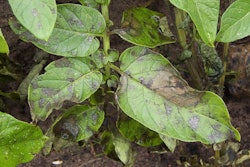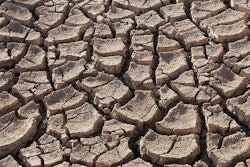 An attractive stone aqueduct from the adjacent building roof brings water to a cistern.
An attractive stone aqueduct from the adjacent building roof brings water to a cistern.Photo: Courtesy of Jeffrey L. Bruce & Co.
As the saying goes, everything old is new again. People have been collecting rainwater for thousands of years; there’s archeological evidence of cisterns built by ancient cultures in Babylonia and Israel. In this country, many 19th century farmhouses have cisterns.
“It’s a very old practice,” says Mark Pape, director of the American Rainwater Catchment Systems Association (ARCSA) and owner of Rain Harvesting Supplies in Denton, Texas. “It’s gaining renewed interest as water restrictions and rates increase.”
Today, rainwater harvesting is used primarily for landscape irrigation, although it’s also utilized as non-potable water for chores such as laundry and even drinking water where water access is challenging or expensive.
“With the growth of our communities, fostering the harvest and reuse of rainwater has become a priority,” says Timothy Malooly, president of Water in Motion in Minneapolis. “It’s also a stormwater management tool, fits into low-impact development principles and earns LEED credits.”
While some states encourage rainwater harvesting, it’s worth noting that in Colorado, it’s illegal to collect rainwater in a cistern or tank for later use. Other states, such as Utah, may require registration with a water rights agency or restrict the amount that can be collected. Check here to see harvesting laws or pending laws in your state.
With profit margins ranging from 20 to 40 percent, rainwater harvesting may be a good addition to your lineup. But you need to understand its scope and complexity. Here’s what else you should know:
Why is rainwater harvesting important?
Ordinances limiting water use are becoming increasingly common as droughts worsen, populations grow and aging infrastructure needs to be updated or replaced.
“In parts of the country, we’re losing access to potable water for use in the landscape,” says Jeffrey Bruce, a landscape architect and president of the Jeffrey L. Bruce & Company in North Kansas City, Missouri. “We need to create a source for ourselves to capture the promise of green infrastructure.”
 An eye-catching blue storage tank and red-and-white downspout fill offer artistic flair.
An eye-catching blue storage tank and red-and-white downspout fill offer artistic flair.Photo: Courtesy of Jeffrey L. Bruce & Co.
It’s not just about whether you’ll be allowed to install irrigation to potable water sources. It’s more a question of whether your business can survive in its current configuration?
“Rainwater is just one component of harvest and reuse technologies. But these techniques will be a natural weed-out for those not serious about their professionalism,” says Malooly. “The time to obtain information about these technologies and take your business seriously is now.”
Expanding your line-up of services to include rainwater harvesting may be wise in states such as Texas and municipalities such as Tucson, where incentives and rebates may make the installation of systems more appealing to clients.
“We’re pro-rainwater harvesting,” says Mindy Conyers, rainwater harvesting coordinator with the Texas Water Development Board. “We look at it as a conservation process, which reduces pressure on the municipal supply.”
How is it accomplished?
Rainwater harvesting systems can be retrofitted to existing buildings or designed for new construction.
“We see it most often on commercial projects such as healthcare facilities and universities,” says Brian Vinchesi, design engineer with Irrigation Consulting in Pepperell, Massachusetts. “But it’s done on residential developments and high-end residential projects, too.”
Regardless of the application, basic components consist of the catchment surface (usually a roof), gutters and downspouts to divert water to the tank, leaf screens or first-flush diverters to filter out debris, one or more storage tanks, and a pump to feed water to the irrigation system.
For every 1,000 square feet of catchment area, 1 inch of rain yields roughly 600 gallons of water.
A backup water source may be connected with the appropriate methods and controls to prevent backflow. In addition, a smart controller is often installed to prevent water waste. For example, the Austin Twin Oaks Library in Texas has a real-time controller on its rainwater harvesting system that integrates weather forecasts, adjusts tank holding capacity in case of an impending storm and redirects overflow to the library’s rain garden.
In some municipalities, harvested water must be purified to drinking-water standards if used in an irrigation system because of the risk of contaminants becoming aerosolized. Thus, additional treatment must occur before water is pumped to the end use. Consult your local plumbing or building code authorities or health or water department to learn the requirements in your area.
 Workers install a 40,000-gallon fiberglass cistern at the Kansas City Performing Arts Center garage in Kansas City, Missouri.
Workers install a 40,000-gallon fiberglass cistern at the Kansas City Performing Arts Center garage in Kansas City, Missouri.Photo: Courtesy of Jeffrey L. Bruce & Co.
Interestingly, the irrigation system that will use the rainwater is designed independently, as its design does not rely on the source of its water supply. “In other words, the irrigation system doesn’t care where its water comes from,” says Vinchesi.
One big issue: There’s no one-size-fits-all design solution. For example, the size of the storage tank or cistern is dictated by variables such as average rainfall, expected demand, and budget.
“One of the biggest challenges is calculating how much water you need to store,” says Mike Clark, president of Clark Irrigation Design & Consulting in Lavonia, Georgia. “How much is the client willing to spend to protect the landscape and not risk losing plant materials?”
Is it right for my business?
Rainwater harvesting is a specialized service which can differentiate you from competitors.
“Be proactive about learning about this growing field,” says Doug Macdonald, principal with Aqua Engineering in Fort Collins, Colorado. “Rainwater harvesting has taken off in some parts of the country. It’s not going to be your sole income, but it’s something you may need to incorporate at some point.”
Rainwater harvesting manuals are available online from states such as Texas and Virginia. Seminars are offered periodically by groups such as the Irrigation Association and Green Roofs for Healthy Cities, as well as ARCSA, which also offers professional accreditation, an online course and new manual. Suppliers who specialize in rainwater harvesting equipment also may provide technical support.
The bottom line is, the industry is changing. “It’s easy to be overwhelmed by the complexity of this issue, but if you keep it ever-present in your mind, you can find simple solutions,” says Bruce. “Build your expertise incrementally, and partner with experts. There’s a huge industry being created in performance-based landscapes. For the innovative, technically-motivated company, rainwater harvesting is a good fit.”










